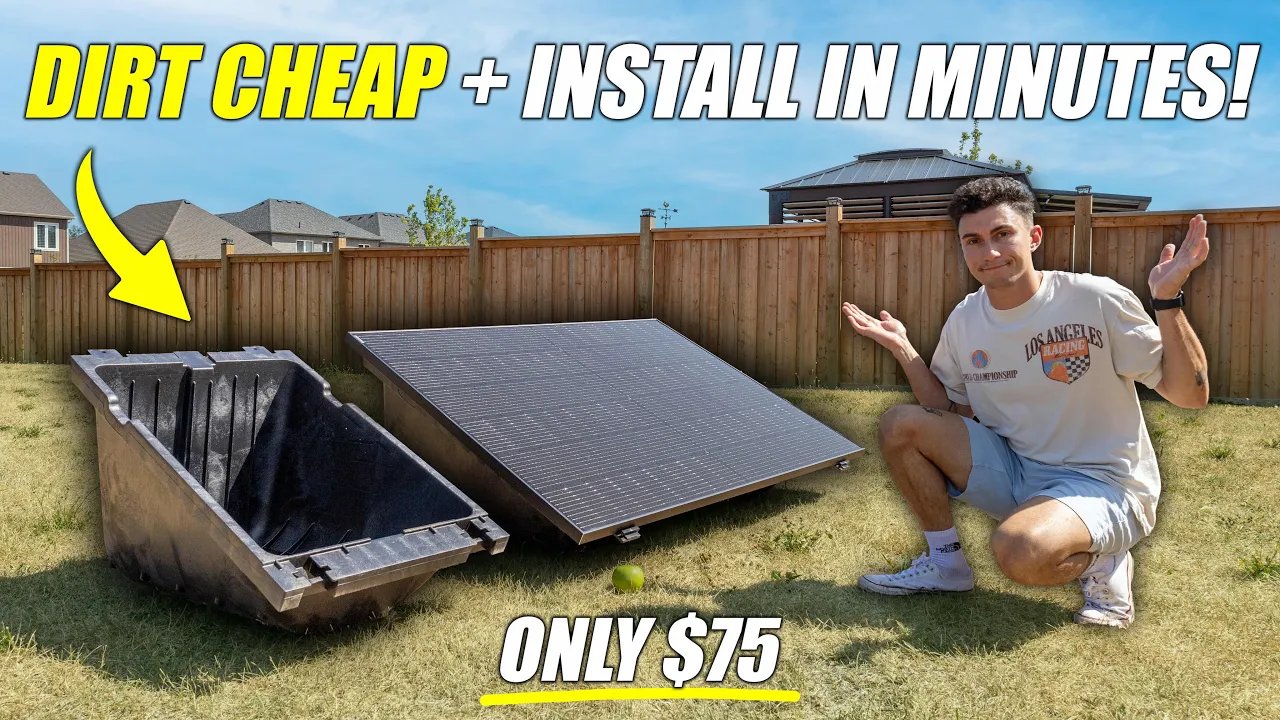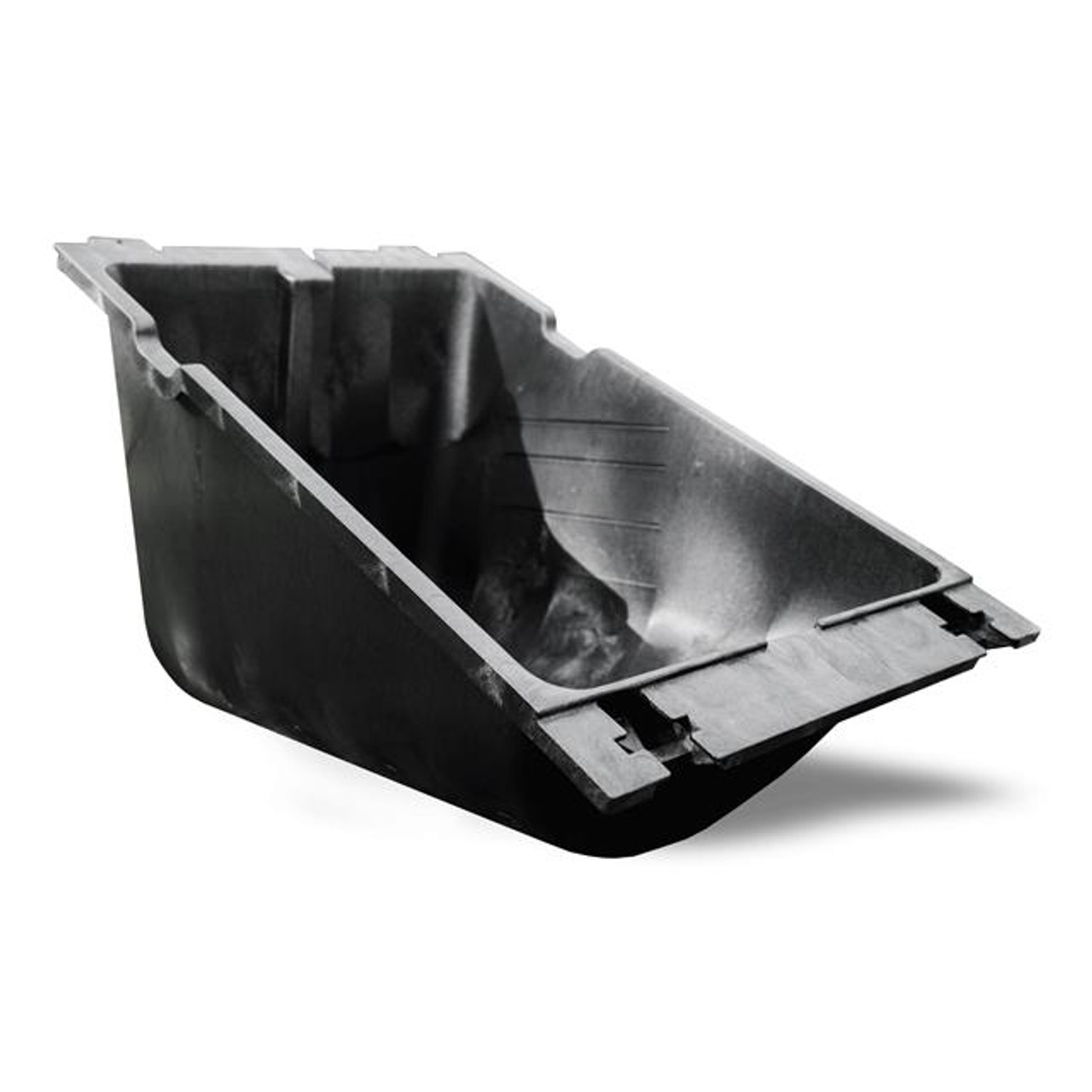

When it comes to solar panel mounts, stands, and racks, you usually expect to spend some real money if you want a sturdy setup. But the PowerField PowerRack is different. It’s cheap, it’s light, it’s made in the U.S., and it might just be the fastest solar panel ground mount we’ve ever put together.
But does the low cost, portability, and quick setup make it the best option for your solar project? Or should you spend a little more for something stronger and more professional-looking? Let’s dig in and find out.
Before we explain everything that we like and dislike about these low-cost solar panel mounts, let’s take a quick look at what you’re getting for your money:
{{review-summary}}
At first glance, the PowerRack looks like a giant heavy-duty plastic bin — because, well, that’s pretty much what it is. Made of high-density polyethylene, each unit weighs only about 17 lbs, but is rated to last decades out in the sun and rain. In fact, PowerField claims up to a 45-year lifespan, and they recently extended the warranty to 25 years. This shows they have a lot of confidence in the durability of these solar mounts.
Each PowerRack has a built-in 25° tilt angle, with about 10° of wiggle room to either side if you’re setting up on uneven ground, or you just want to use stakes to tilt it. The treaded base also helps grip the surface, while holes in the bottom let you stake or anchor it in place if you want added stability. We suspect that most people would just choose to fill the bottom of the bin with rocks, soil, or sand to keep it steady.
Cable management dimples along the sides also keep wiring neat, and the included clips hold panels in place. Just like Rubbermaid bins, these solar panel mounts are also stackable, which makes them much easier to transport, including to remote off-grid locations.
PowerField claims that these bins have been wind tunnel tested to ensure that they’re suitable in all weather conditions, but we think they’d pretty much fly away if they weren’t weighed down or staked into place.
The system comes in two sizes: the PowerRack 1000 (for smaller panels) and the PowerRack 1200 (for larger ones). You’ll need to measure your panels carefully to make sure they fit the bin’s dimensions. The basic PowerRack 1000 Solar Racks that we tested require a minimum solar panel width of 37.8” and a maximum width of 41.3”, but we’re not sure how much wider the PowerRack 1200 Mounts are.
In what is probably their most appealing feature, they’re very affordable. Right now, Signature Solar carries them for as little as $75 each, making them the cheapest solar panel mount we’ve ever tested.
Now that you know what you’re getting when you order this simplified ground mount system, let’s take a look at all of the things we really liked about them:
Aside from the dirt-cheap price, the biggest selling point is how fast and easy the PowerRacks are to set up. You don’t need tools, instructions, or special skills. Just drop it on the ground, slide in your solar panel, clip it in place, and you’re done. Honestly, your grandma could set one up in minutes.
Sure, you’ll need to add some kind of fill to keep them in place in windy environments, but that can be as easy as tossing in a few sand bags, or just shoveling in whatever dirt or gravel you have on hand.
We also love how portable and modular they are. Because they’re lightweight, you can throw a stack of them in the back of a truck, ATV, or even just carry them anywhere they're needed. For temporary setups, as well as off-grid locations, this can be a game-changer.
Having recently transported some sections of the heavyweight Chiko GroundFlex Solar Panel Mount to an off-grid tiny home, we can’t stress how appealing a lightweight and portable solar panel mount will be for certain installs.
Once you get them to your desired location, all you have to do is fill them with dirt, gravel, or sand, then attach your panels. Voila! You’ve got instant ground-mounted solar panel system.
That simplified setup and portability makes them great for temporary solar panel setups at events, festivals, off-grid properties, trade shows, farms, or pretty much any other situation where you’d need mobile solar power.
The design is simple, but that is also key to their impressive durability. Even though they’re only 17 lbs, they’re made incredibly tough. The fact PowerField also provides a 25-year warranty on these things is just a testament to the manufacturer's confidence in their quality.
When we tested them, we found them surprisingly wind-resistant. Since the attached solar panels sit low to the ground, there’s less wind load compared to tall steel racks that can act almost like sails. For most off-grid environments, that extra stability is going to be a real plus.
They also have UV resistance, which is important when you’re talking about plastic components that are designed to sit in the sun every single day.
And let’s not forget, they’re incredibly cheap. At $75, nothing else really comes close. We’ve even tested low-cost Amazon solar panel ground mounts, like the Eco-Worthy Ground Mount, which still cost more than these PowerRack Mounts.
When you add in the 45-year lifespan PowerField claims, you’re talking about something that’s really cheap, but will last longer than the solar panels you attach to it. Even if you have to pay extra for fill materials, they’re crazy cheap.
Another really cool thing about PowerRacks is that they can be used as either permanent or portable solar panel stands. For permanent installs, you can stake or anchor them and fill them with material. For portable use, you can skip the heavy fill and just weigh them down with unopened sandbags, then empty them out when it’s time to move on.
That flexibility is a big reason why so many people, from homeowners to food truck operators and off-grid cabin owners, are choosing them. Plus, when you don’t need them, you can just stack them up in a garage or shed, then pull them out when you need them again.
While there was a lot to like about these cheap solar panel mounts, they weren’t perfect. Here’s a few of the issues we found when we were testing them:
The first issue is panel compatibility. The PowerRacks aren’t sized for general wattage ranges (like 200 to 400 Watt solar panels). Instead, they’re sized for exact dimensions. That means many standard solar panels won’t fit correctly.
In our testing, none of the 100W to 570W panels we had laying around at The Solar Lab fit properly without hanging over or leaving gaps at the bottom. It’s definitely something you’re going to have to consider if you want to go with these as your main solar panel racking system.
We’d probably just recommend buying your solar panels directly through Signature Solar when you're also picking up the PowerRacks. Since Signature Solar carries a ridiculous variety of solar panels, you’ll be able to order something that you know will be compatible.
The second issue we came across was just the fact that the mounting clips are plastic. While they’re made from thick plastic and they’re easy to use, we don’t see them lasting 25 years, especially in cold winters, where plastic can get brittle and break.
The bin itself feels solid, but the clips definitely feel like they could be a weak point. Most of the solar panel mounts we test come with metal panel clips, so we were a little surprised to see plastic clips here.
While the advertised price for the PowerRack System is very low, the true cost can creep up when you consider the extra materials that you’ll need to keep them in place.
You’ll need a fill material like sand or gravel, or some sort of ground anchors, which adds money and labor to the final costs. Once you factor that in, the PowerRacks don’t look quite as cheap compared to sturdier mounts. Don’t get us wrong, they’re still super cheap, but fill costs are worth considering, especially if you’re planning on installing a huge number of them.
With that said, some people are going to have extra soil and rocks laying around that they can use, especially those installing them in rural or off-grid locations. However, you’ll probably have to go out and buy some gravel or sand if you’re going with a backyard solar panel setup in a residential area.
Lastly, they’re not the most aesthetically pleasing solar panel mounting solution out there. From a distance, they still look like plastic bins with solar panels stuck on top of them.
If you’re lining them up in a yard or farm field, the look can be uneven compared to professional-looking steel or aluminum mounts. Take the IntegraRack Ground Mount System, which is only about $120 per section, but looks significantly nicer and more professional than the PowerRacks.
The PowerField PowerRack Solar Module Mounting Rack is far from perfect, but for the price, it’s a clever and versatile option. They’re incredibly easy to set up, portable, modular, and surprisingly stable in the wind and rain.
On the other hand, you’ll need to make sure your panels are the right size, the plastic clips may not last forever, and the true cost can creep higher than expected if you decide to buy fill materials or anchor stakes.
Still, at $75 per mount, these are the cheapest solar panel racks on the market, and we can see why Signature Solar continues to sell so many of them. If you need a quick, simple, and portable way to ground-mount panels, the PowerRack is absolutely worth considering.
If you’re still unsure how you want to mount your solar panels, we have a guide that breaks down some of the best options out there right now: Best Solar Panel Ground Mounts Reviewed and Ranked
